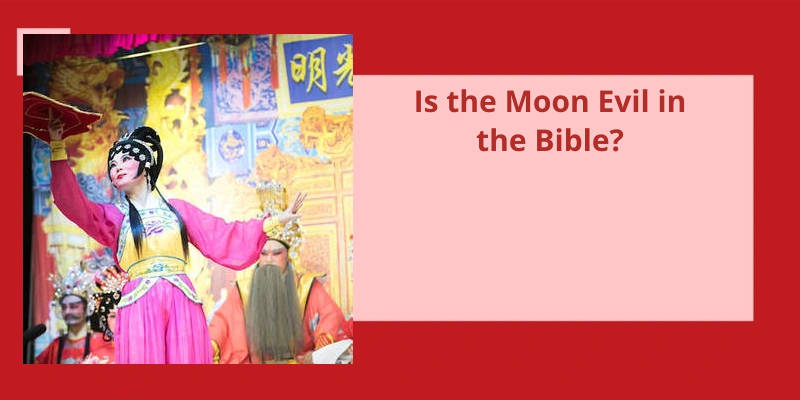The profound influence of the moon has captivated humanity throughout history, inspiring a multitude of myths, legends, and religious interpretations. In the realm of biblical teachings, the moon assumes a prominent role, symbolizing various aspects of divinity and spiritual significance. Within the context of biblical narratives, the moon is presented as a celestial body that can be used for navigation, timekeeping, and as a source of light. However, it also carries connotations of darkness, deception, and the potential for evil influences. Exploring it’s multifaceted nature, we embark on a journey to uncover the biblical references, symbolism, and interpretations surrounding the notion of the moon's relationship with evil.
What Does the Moon Symbolize in Christianity?
The moon has significant symbolism in Christianity, representing various themes and ideas. Biblically, references to the moon often highlight cosmic events, divine epiphanies, and the ephemeral nature of human life and history. In Isaiah 30:26 and 60:19, for instance, the moon is associated with the coming of the Messianic age, signifying the restoration of Gods divine order. Here, the moons presence emphasizes the magnificence of the divine presence and the promise of salvation.
The book of Revelations also contains references to the moon as a symbol, particularly in chapter 21, verse 2In this passage, the moons symbolism takes on a different tone. It’s described as unnecessary, as the glory of God and the Lamb illuminate the heavenly city, New Jerusalem, with their divine radiance. Here, the moons insignificance represents the consummation of Gods everlasting kingdom, where the need for lesser celestial bodies diminishes in the presence of Gods eternal light.
Furthermore, the moons waxing and waning, it’s cyclical phases, can metaphorically reflect the ephemeral nature of human life and history. Just as the moon changes it’s appearance, so do people and their circumstances. This symbolism reminds believers of the fleeting nature of worldly pursuits and emphasizes the need for an eternal perspective anchored in faith.
This dichotomy is evident in the juxtaposition of darkness during a lunar eclipse and the radiant light of a full moon. By underscoring this duality, the moon serves as a reminder of the ongoing spiritual battle between light and darkness, urging believers to choose the path of righteousness.
It serves as a reminder of the divine order and the ongoing struggle between good and evil, urging believers to seek spiritual enlightenment and eternal perspectives in the face of lifes fleeting circumstances.
The Moon as a Symbol of God’s Creation: The Article Could Explore the Significance of the Moon as One of God’s Creations and How It Reflects the Beauty and Intricacy of the Natural World.
- The moon is a symbol of God’s creation
- It reflects the beauty and intricacy of the natural world
- It’s changing phases represent the cycle of life and renewal
- Many cultures and religions have myths and legends about the moon
- It’s often associated with femininity and fertility
- The moon’s gravitational pull affects the tides and influences nature
- Scientists continue to study and explore the moon’s mysteries
- It’s serene presence in the night sky brings solace and wonder
- Looking at the moon can inspire feelings of awe and connection
- Ultimately, the moon serves as a reminder of God’s creative power
In the book of Deuteronomy, God addresses the Israelites’ tendency to be captivated by the celestial bodies. He urges them not to succumb to the allure of idolatry by worshiping the sun, the moon, or the stars. Instead, He emphasizes that these celestial wonders are part of His divine creation, intended for the enjoyment of all nations. Let’s explore further what God reveals about the moon and stars, and the perspective we should have towards them.
What Did God Say About the Moon and Stars?
In Deuteronomy 4:19, God warns against the worship of celestial bodies such as the sun, moon, and stars. He emphasizes that these heavenly objects are part of His creation and shouldn’t be worshipped as gods. Instead, God encourages His people to recognize that He’s the one who’s apportioned these celestial bodies to all nations under heaven.
The mention of the moon and stars in this verse signifies their significance in the ancient world. The moon was often associated with fertility, while the stars were seen as divine beings or celestial guides. However, God makes it clear that these celestial bodies aren’t to be revered or worshipped in the same manner as Him.
By cautioning against the worship of the moon and stars, God reinforces His position as the one and only true God. He wants His people to focus their devotion and worship solely on Him, acknowledging His sovereignty over all creation. This serves to protect His people from falling into the trap of idolatry, ensuring their spiritual well-being and fidelity to His commandments.
It’s important to note that the moon and stars themselves aren’t inherently evil according to the Bible. Rather, it’s the act of worshipping these creations instead of the Creator that God speaks against. The moon and stars are part of Gods beautiful and intricate design, serving as awe-inspiring reminders of His power and majesty.
The verse highlights the importance of sole devotion to the true God and serves as a warning against the sin of idolatry.
The Role of the Moon and Stars in Biblical Narratives and Symbolism.
- The moon is often mentioned in the Bible as a celestial body that provides light in the night sky.
- In the book of Genesis, the creation story includes the account of God creating the moon on the fourth day of creation.
- In the book of Psalms, the moon is praised for it’s beauty and for it’s role in marking the seasons.
- Throughout the Bible, the moon is also associated with appointed times and feasts.
- Stars have a significant role in biblical narratives and symbolism as well.
- In the book of Genesis, the stars are described as being created by God on the fourth day along with the moon.
- The stars are often mentioned in the context of God’s promises and blessings.
- In the book of Matthew, the birth of Jesus is accompanied by the appearance of a star, which is interpreted as a sign of His coming.
- Stars are also used metaphorically in the Bible to represent God’s guidance and the righteous.
In the book of Psalms, there are several verses that mention the moon and it’s significance. Psalm 136:9 acknowledges the moon and stars as rulers of the night, emphasizing the everlasting mercy of God. Psalm 148:3 calls for the praise of the sun, moon, and stars, recognizing their role in the creation. Lastly, Psalm 72:5 declares that the fear and reverence for God will endure as long as the sun and moon exist, spanning across all generations. These verses highlight the moon’s symbolic and celestial importance in the biblical context.
What Bible Verse Talks About the Moon?
In the Bible, there are several verses that mention the moon and it’s significance. One such verse is Psalm 136:9, which states that the moon and stars have been appointed to rule by night, highlighting their integral role in the celestial order. It emphasizes the everlasting mercy of God, which endures forever.
Another verse, Psalm 148:3, encourages praise for the sun, moon, and all the stars of light. This verse recognizes the divine creation of these celestial bodies and invites believers to acknowledge the power and beauty they possess. It serves as a reminder of the magnificence of Gods creation and the importance of offering praise to the Creator.
Psalm 72:5 further asserts the enduring nature of the sun and the moon, symbolizing the constancy and authority of God. It suggests that the fear and reverence for God will persist throughout all generations, just as the sun and moon continue to exist. This verse implies that the moon, like the sun, carries a sense of awe and reverence due to it’s enduring presence.
It’s important to note that these verses don’t portray the moon as evil or malevolent in any way. Instead, they emphasize it’s role in Gods creation and highlight it’s significance in the nighttime sky. The moon is seen as a celestial body deserving of praise and awe, rather than being associated with evil or negativity.
In the Book of Joel in the Bible, it’s mentioned that before the great and terrible day of the Lord, the sun shall be turned into darkness and the moon into blood. This prophetic phrase signifies a judgment for eternal rewards. The concept of the day of the Lord is further described in the Book of Revelation as a time of God’s wrath upon the wicked. This apocalyptic event is depicted as a terrifying period of divine judgment.
Where in the Bible Does It Say the Moon Will Turn to Blood?
In the Bible, the phrase “the moon shall turn to blood” is mentioned in Joel 2:3This verse refers to a prophetic event that signifies the great and terrible day of the Lord. The day of the Lord is described in the Book of Revelation as a time of Gods judgment and wrath upon the wicked.
The concept of the moon turning to blood is often associated with apocalyptic imagery, symbolizing the severity and magnitude of the impending judgment. It serves as a powerful metaphor for the cosmic and supernatural events that will occur during this period.
The day of the Lord is a recurring theme in the Bible, emphasizing the ultimate accountability and justice that awaits the wicked. It serves as a reminder of Gods sovereignty and His righteous judgment, urging people to repent and turn towards Him.
Rather than depicting evil or malevolence, it signifies divine justice and the consequences of wickedness.
Interpretations of the Phrase “The Moon Shall Turn to Blood” by Different Religious Traditions
The phrase “the moon shall turn to blood” appears in different religious texts and has been interpreted differently by various religious traditions.
In the Bible, specifically in the Book of Joel and the Book of Revelation, this phrase is used in apocalyptic imagery, suggesting celestial signs associated with the end times. It symbolizes cosmic disturbances, judgments, and the coming of divine wrath.
However, the interpretation of the moon turning to blood varies among religious groups. Some Christian denominations interpret it as a literal event that will happen in the future, while others see it as metaphorical, representing a significant change or upheaval.
In contrast, certain Native American traditions view the moon turning red as a positive sign associated with renewal and spiritual growth. It symbolizes the cycles of nature, the seasons, and the importance of living in harmony with the Earth.
Ultimately, the interpretation of this phrase depends on the religious and cultural context in which it’s examined. Different traditions may derive distinct meanings and symbolism from the same celestial imagery.
The worship of celestial bodies, including the moon, has been documented in various ancient cultures. In the context of the Bible, there are references to moon worship in Israelite and Judahite sources. This religious practice is believed to have been prevalent in both kingdoms, persisting prior to the Babylonian captivity and even continuing in some form thereafter. Exploring these historical and textual references sheds light on the significance of moon worship within the religious landscape of ancient Israel and Judah.
Who Worshipped the Moon in the Bible?
The worship of the moon in ancient Israel and Judah is a topic that’s somewhat shrouded in mystery. While the Bible doesn’t provide explicit evidence of widespread moon worship in these kingdoms, there are several indications that suggest it’s presence. In both pre- and post-Babylonian captivity eras, it’s likely that certain factions within the Israelite and Judahite society engaged in the veneration of the moon.
In the biblical text, there are references to the worship of celestial bodies, including the moon, by Israelites and Judahites. For example, in the book of 2 Kings, there are mentions of people who “worshipped all the host of heaven” (2 Kings 17:16). This could include the moon, as well as other celestial bodies. Additionally, in the book of Jeremiah, there are condemnations of those who worshiped “the queen of heaven” (Jeremiah 7:18; 44:17-25), which scholars believe to be a reference to the moon goddess.
For instance, various inscriptions and artifacts have been discovered that depict symbols associated with lunar deities. These include representations of the crescent moon, which is often associated with moon worship in ancient Near Eastern cultures.
It’s important to note, however, that the biblical texts primarily focus on the condemnation and prohibition of such idolatrous practices. The Israelite and Judahite prophets repeatedly denounced the worship of any deity other than Yahweh, the God of Israel. These condemnations suggest that moon worship, along with the worship of other celestial beings, was viewed as a form of apostasy and a violation of the central tenets of Hebrew monotheism.
Nevertheless, it’s important to consider that the biblical texts primarily condemn such practices, emphasizing the worship of Yahweh alone.
How Did Moon Worship Influence Ancient Near Eastern Cultures Outside of Israel and Judah?
Moon worship held significant influence in various ancient Near Eastern cultures that were outside of Israel and Judah. The worship of the moon can be traced back to prehistoric times, and it remained a prominent aspect of religious beliefs for centuries.
Many civilizations considered the moon as a divine entity and attributed various powers to it. They regarded the moon as a god or goddess, associating it with fertility, cycles, and renewal. These beliefs often led to the construction of temples dedicated to lunar deities and the development of specific rituals and practices.
Ancient Mesopotamia, for instance, worshipped Sin (Nanna), the god of the moon. Sin was viewed as a powerful deity who controlled the lunar phases and directly influenced human affairs. The city of Ur, within Mesopotamia, had a notable ziggurat, the E-Gish-Shir-Gal, which was associated with moon worship.
The cultures of Canaan, Phoenicia, and Carthage also held moon worship as a significant element of their religious systems. They revered the god Baal and his female counterpart Astarte, who were closely associated with the moon. These deities had temples and rituals dedicated to their worship.
Despite the prevalence of moon worship among neighboring civilizations, the Israelites and Jews were explicitly instructed in the Hebrew Bible (Old Testament) to worship only the God of Israel, Yahweh. The Israelite religious tradition strongly condemned idolatry and the worship of celestial bodies, including the moon.
In conclusion, moon worship exerted considerable influence on various ancient Near Eastern cultures, playing a central role in their religious practices and belief systems. However, the Israelite and Jewish traditions diverged from this prevalent worship, adhering to a monotheistic faith that rejected the deification of celestial bodies such as the moon.
Source: Yarikh – Wikipedia
In one of the most remarkable episodes in the Bible, Joshua, the leader of the Israelites, seeks divine intervention during a crucial battle. With unwavering faith, he implores God to halt the movement of the sun and moon, ensuring that daylight lingers and aids their fight against the Canaanites. God, in His might, not only stops the celestial bodies but also unleashes a tempestuous storm, assisting Joshua and his army with relentless rain and hailstones. This extraordinary event showcases the supernatural power at work, highlighting the unwavering belief and reliance on divine intervention in challenging times.
Who Stopped Sun and Moon in the Bible?
In the Bible, there’s a pivotal and incredible event where Joshua, the leader of the Israelites, called upon Gods assistance to halt the sun and the moon in their tracks. This miraculous occurrence enabled Joshua and his army to continue their battle against the Canaanites under the cover of daylight. Joshuas plea to God demonstrates his unwavering faith and the supernatural power at his disposal.
The notion of the moon being evil in the Bible isn’t explicitly stated; rather, the emphasis lies on Gods sovereignty and his ability to control celestial bodies for the benefit of his chosen people. The narrative surrounding Joshuas command over the sun and the moon serves as a testament to Gods power and Joshuas faith. It highlights the belief that God can manipulate the natural order to aid those who trust in Him.
Conclusion
While there are passages that associate darkness and lunar symbolism with negative connotations, it’s important to consider the broader context in which these scriptures were written. The moon itself is a celestial object, devoid of moral agency. Therefore, it’s more accurate to view the moon as a symbol that represents various themes such as time, cycles, and contrasting forces, rather than attributing intrinsic malevolence to it. Ultimately, the interpretation of the moon's symbolism in the Bible depends on individual perspectives and theological understandings.






